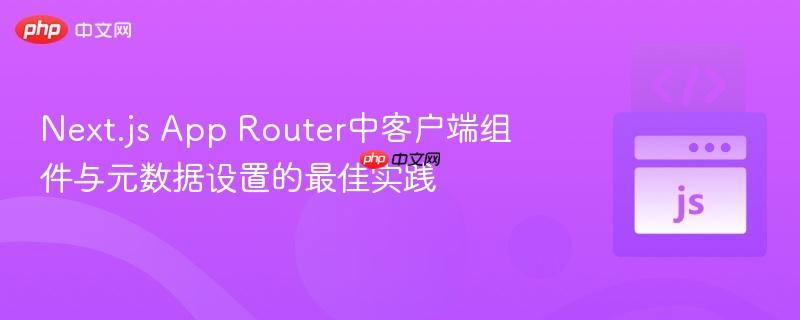
在next.js app router中,客户端组件无法直接定义页面元数据(如标题)。本文将深入探讨这一限制的原因,并提供一种将交互逻辑封装在客户端组件中,同时在服务器组件中管理元数据的最佳实践。通过将组件拆分为服务器端和客户端,可以确保页面标题等元数据能被正确设置,同时不影响客户端交互功能,进而优化应用性能和seo。
Next.js 13及更高版本的App Router引入了服务器组件(Server Components)和客户端组件(Client Components)的概念,这彻底改变了组件的渲染方式和数据获取策略。其中,元数据(metadata)的处理是这一架构中的一个关键点。
根据Next.js官方文档的明确说明,无论是通过静态对象定义的metadata还是通过generateMetadata函数动态生成的元数据,都只在服务器组件中受支持。这意味着,当一个文件顶部声明了'use client',将其标记为客户端组件时,其中定义的export const metadata = {...}将不会生效。
为什么会有这样的限制? 服务器组件在服务器上渲染,能够直接访问文件系统、数据库或执行其他服务器端逻辑,并在将HTML发送到客户端之前,将元数据注入到页面的
标签中。这对于SEO(搜索引擎优化)至关重要,因为搜索引擎爬虫在抓取页面时,会优先读取HTML文档头部的元数据。而客户端组件则在浏览器中渲染,它们在服务器发送的初始HTML之后才开始执行,此时标签的内容通常已经确定。因此,在客户端组件中定义元数据,将无法在服务器渲染阶段被有效处理。考虑以下在Next.js App Router中遇到的典型问题:
// app/demo/page.js
'use client' // 声明为客户端组件
import React, { useState } from 'react';
// 假设这里引入了ModalJS库和样式
// import ModalJS from 'path/to/ModalJS';
// import styles from './demo.module.css';
export const metadata = { // 此处的metadata将不会生效
title: 'Demo - ModalJS',
};
export default function Demo() {
const [title, setTitle] = useState("Title of your modal");
const [desc, setDesc] = useState("You description goes here");
const [theme, setTheme] = useState("light");
const handleclick = ()=>{
// const modal = new ModalJS( ... stuff related to this library)
// modal.show()
alert(`Showing modal with title: ${title}, desc: ${desc}, theme: ${theme}`);
}
return (
<section /*id={styles.demosection}*/>
<div /*className={styles.demotitle}*/>Demo</div>
<div /*className={styles.form}*/>
<label htmlFor="title" /*className={styles.label}*/>Title:</label> <br />
<input type="text" name="title" id="title-input" /*className={styles.input}*/ value={title} onChange={(e)=>setTitle(e.target.value)}/>
<br /><br />
<label htmlFor="desc" /*className={styles.label}*/>Description:</label> <br />
<input type="text" name="desc" id="desc-input" /*className={styles.input}*/ value={desc} onChange={(e)=>setDesc(e.target.value)}/>
<br /><br />
<label htmlFor="theme" /*className={styles.label}*/>Theme:</label> <br />
<select name="theme" id="theme-select" /*className={styles.input}*/ onChange={(e)=>setTheme(e.target.value)}>
<option value="light">light</option>
<option value="dark">dark</option>
</select>
<br /><br />
</div>
<div /*className={styles.showbtndiv}*/>
<button /*className={styles.showbtn}*/ onClick={handleclick}>Show Modal</button>
</div>
</section>
);
}在这个例子中,由于app/demo/page.js被标记为'use client',其中定义的metadata.title将不会被Next.js识别和应用,导致页面标题仍然显示为默认的localhost:3000/demo。然而,移除'use client'又会导致组件内部的useState和onClick等交互逻辑报错,因为它们是客户端特有的React Hooks。
Next.js推荐的最佳实践是“将客户端组件移至组件树的叶子节点”(Moving Client Components to the Leaves)。这意味着,只在确实需要客户端交互逻辑(如useState, useEffect, onClick等)的最小部分使用'use client',而将大部分结构和数据获取逻辑保留在服务器组件中。
针对上述问题,我们可以将页面拆分为一个服务器组件作为页面的入口(负责定义元数据和整体布局),以及一个客户端组件(负责具体的交互逻辑)。
首先,我们创建一个服务器页面组件app/demo/page.js。这个组件将负责定义页面的元数据,并导入实际包含交互逻辑的客户端组件。
// app/demo/page.js (服务器组件)
import React from 'react';
import DemoClientComponent from './DemoClientComponent'; // 导入客户端组件
// 在服务器组件中定义元数据,这将确保页面标题被正确设置
export const metadata = {
title: 'Demo - ModalJS',
description: 'A demonstration page for ModalJS library.',
};
export default function Page() {
return (
<div>
<h1>ModalJS Demo Page</h1>
{/* 在服务器组件中渲染客户端组件 */}
<DemoClientComponent />
</div>
);
}接着,我们将原先页面中所有需要客户端交互的代码(包括useState、onClick等)提取到一个新的文件中,并将其标记为客户端组件。
// app/demo/DemoClientComponent.js (客户端组件)
'use client' // 声明为客户端组件
import React, { useState } from 'react';
// 假设这里引入了ModalJS库和样式
// import ModalJS from 'path/to/ModalJS';
// import styles from './demo.module.css';
export default function DemoClientComponent() {
const [title, setTitle] = useState("Title of your modal");
const [desc, setDesc] = useState("You description goes here");
const [theme, setTheme] = useState("light");
const handleclick = ()=>{
// 实际的ModalJS库调用
// const modal = new ModalJS({ title, desc, theme });
// modal.show();
alert(`Showing modal with title: ${title}, desc: ${desc}, theme: ${theme}`);
}
return (
<section /*id={styles.demosection}*/>
<div /*className={styles.demotitle}*/>Demo Interaction</div>
<div /*className={styles.form}*/>
<label htmlFor="title" /*className={styles.label}*/>Title:</label> <br />
<input type="text" name="title" id="title-input" /*className={styles.input}*/ value={title} onChange={(e)=>setTitle(e.target.value)}/>
<br /><br />
<label htmlFor="desc" /*className={styles.label}*/>Description:</label> <br />
<input type="text" name="desc" id="desc-input" /*className={styles.input}*/ value={desc} onChange={(e)=>setDesc(e.target.value)}/>
<br /><br />
<label htmlFor="theme" /*className={styles.label}*/>Theme:</label> <br />
<select name="theme" id="theme-select" /*className={styles.input}*/ onChange={(e)=>setTheme(e.target.value)}>
<option value="light">light</option>
<option value="dark">dark</option>
</select>
<br /><br />
</div>
<div /*className={styles.showbtndiv}*/>
<button /*className={styles.showbtn}*/ onClick={handleclick}>Show Modal</button>
</div>
</section>
);
}通过这种方式,app/demo/page.js作为一个服务器组件,能够成功地定义并应用页面的元数据,因为它在服务器上渲染。而所有的交互逻辑则被封装在DemoClientComponent.js这个客户端组件中,确保了useState和onClick等功能能够正常运行。服务器组件只负责渲染客户端组件,而客户端组件则在浏览器中“激活”其交互性。
Next.js App Router的服务器组件和客户端组件模型为我们提供了强大的灵活性,但也要求我们理解其工作原理和限制。当需要在页面中同时处理元数据和客户端交互时,最佳实践是将页面的元数据定义在服务器组件中,并将所有依赖于'use client'的交互逻辑封装到独立的客户端组件中,然后由服务器组件导入并渲染。这种模式不仅解决了元数据无法生效的问题,还优化了应用性能和可维护性,是构建高性能、SEO友好Next.js应用的基石。
以上就是Next.js App Router中客户端组件与元数据设置的最佳实践的详细内容,更多请关注php中文网其它相关文章!

每个人都需要一台速度更快、更稳定的 PC。随着时间的推移,垃圾文件、旧注册表数据和不必要的后台进程会占用资源并降低性能。幸运的是,许多工具可以让 Windows 保持平稳运行。

Copyright 2014-2025 https://www.php.cn/ All Rights Reserved | php.cn | 湘ICP备2023035733号